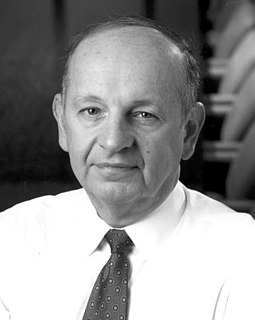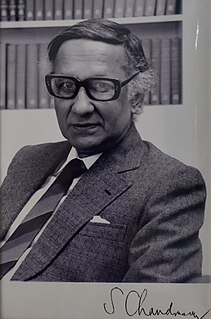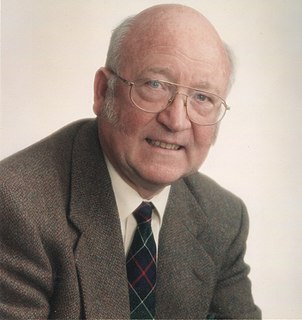Related Research Articles
The Royal Radar Establishment was a research centre in Malvern, Worcestershire in the United Kingdom. It was formed in 1953 as the Radar Research Establishment by the merger of the Air Ministry's Telecommunications Research Establishment (TRE) and the British Army's Radar Research and Development Establishment (RRDE). It was given its new name after a visit by Queen Elizabeth II in 1957. Both names were abbreviated to RRE. In 1976 the Signals Research and Development Establishment (SRDE), involved in communications research, joined the RRE to form the Royal Signals and Radar Establishment (RSRE).

Pierre-Gilles de Gennes was a French physicist and the Nobel Prize laureate in physics in 1991.

John Bannister Goodenough is an American materials scientist, a solid-state physicist, and a Nobel laureate in chemistry. He is a professor of electrical and computer engineering at the University of Texas at Austin. He is widely credited with the identification and development of the lithium-ion battery, for developing the Goodenough–Kanamori rules in determining the sign of the magnetic superexchange in materials, and for seminal developments in computer random-access memory.

John Werner Cahn was an American scientist and recipient of the 1998 National Medal of Science. Born in Cologne, Weimar Germany, he was a professor in the department of metallurgy at the Massachusetts Institute of Technology (MIT) from 1964 to 1978. From 1977, he held a position at the National Institute of Standards and Technology. Cahn had a profound influence on the course of materials research during his career. One of the foremost authorities on thermodynamics, Cahn applied the basic laws of thermodynamics to describe and predict a wide range of physical phenomena.

Sir Frederick Charles Frank, OBE, FRS, known as Sir Charles Frank, was a British theoretical physicist. He is best known for his work on crystal dislocations, including the idea of the Frank–Read source of dislocations. He also proposed the cyclol reaction in the mid-1930s, and made many other contributions to solid-state physics, geophysics, and the theory of liquid crystals.

Sir John Roy Sambles is an English experimental physicist and a former President of the Institute of Physics.
George William Gray was a Professor of Organic Chemistry at the University of Hull who was instrumental in developing the long-lasting materials which made liquid crystal displays possible. He created and systematically developed liquid crystal materials science, and established a method of practical molecular design. Gray was recipient of the 1995 Kyoto Prize in Advanced Technology.

Martin Schadt is a Swiss physicist and inventor.

George Harry Heilmeier was an American engineer, manager, and a pioneering contributor to liquid crystal displays (LCDs), for which he was inducted into the National Inventors Hall of Fame. Heilmeier's work is an IEEE Milestone.
In chemistry and chemical physics, a mesophase is a state of matter intermediate between liquid and solid. Gelatin is a common example of a partially ordered structure in a mesophase. Further, biological structures such as the lipid bilayers of cell membranes are examples of mesophases.

Sivaramakrishna Chandrasekhar FNA, FRS was an Indian physicist who won the Royal Medal in 1994. He was the founder-president of the International Liquid Crystal Society.

4-Cyano-4'-pentylbiphenyl is a commonly used nematic liquid crystal with the chemical formula C18H19N. It frequently goes by the common name 5CB. 5CB was first synthesized by George William Gray, Ken Harrison, and J.A. Nash at the University of Hull in 1972 and at the time it was the first member of the cyanobiphenyls. The liquid crystal was discovered after Gray's group received a grant from the UK Ministry of Defence to find a liquid crystal that had liquid crystal phases near room temperature with the specific intention of using them in liquid crystal displays. The molecule is about 20 Å long. The liquid crystal 5CB undergoes a phase transition from a crystalline state to a nematic state at 24 °C and it goes from a nematic to an isotropic state at 35 °C.
Brendan Kevin Patrick Scaife FTCD, MRIA, Boyle Laureate, is an Irish academic engineer and physicist who carried out pioneering work on the theory of dielectrics. Scaife founded the Dielectrics Group in Trinity College Dublin where he is Fellow Emeritus and formerly Professor of Electromagnetism, and previously to that a professor of engineering science. Scaife showed that in a linear system the decay function is directly proportional to the autocorrelation function of the corresponding fluctuating macroscopic variable, and proved how the spectral density of the dipole moment fluctuations of a dielectric body could be calculated from the frequency dependence of the complex permittivity, . It was independent of Ryogo Kubo who in 1957 developed the corresponding theory for magnetic materials. The work was published prior to the work of Robert Cole in 1965 which is often cited.

Professor Frank Matthews Leslie FRS FRSE was a Scottish mathematical physicist specializing in continuum mechanics. He is remembered for the Ericksen–Leslie Theory which he developed with Jerald Ericksen to describe the viscosity of mesophases associated with liquid crystals. The parameters of this theory are viscosities called "Leslie coefficients", and the angle at which a nematic orientates with respect to the direction of flow in a steady shear flow is called the "Leslie angle".
The de Gennes Prize was established in 2008 and is awarded biennially by the Royal Society of Chemistry for outstanding and exceptional work in the field of materials chemistry. The de Gennes Prize honours the work of Pierre-Gilles de Gennes.
The Materials for Industry - Derek Birchall Award is awarded biennially to an individual who has made an exceptional contribution to the application of materials chemistry in industry. The recipient of the award is chosen by an independent committee consisting of experts from both the Materials Chemistry Division (MCD) and industry. The award is given by the Royal Society of Chemistry and the chosen winner is rewarded with a monetary prize of £2000.

Andrew Ian Cooper FRS is Professor of Chemistry in the Department of Chemistry at the University of Liverpool.
Ranganathan Shashidhar is a US-based Indian condensed matter physicist and a former head of the Laboratory for Molecularly Engineered Materials and Surface of the Center for Biomolecular Science & Engineering, a division of the United States Naval Research Laboratory. Known for his research on liquid crystals, Shashidhar is an elected fellow of the Indian Academy of Sciences and the senior vice president of Polestar Technologies, a US-based company involved in the development of sensing technologies. The Council of Scientific and Industrial Research, the apex agency of the Government of India for scientific research, awarded him the Shanti Swarup Bhatnagar Prize for Science and Technology, one of the highest Indian science awards, for his contributions to Physical Sciences in 1984.
Nelamangala Vedavyasachar Madhusudana is an Indian physicist and an emeritus scientist at Raman Research Institute. Known for his research on liquid crystals, Madhusudhana is an elected fellow of Indian Academy of Sciences and Indian National Science Academy. The Council of Scientific and Industrial Research, the apex agency of the Government of India for scientific research, awarded him the Shanti Swarup Bhatnagar Prize for Science and Technology, one of the highest Indian science awards, for his contributions to physical sciences in 1989.
Robert Bruce Meyer is an American physicist and professor at Brandeis University.